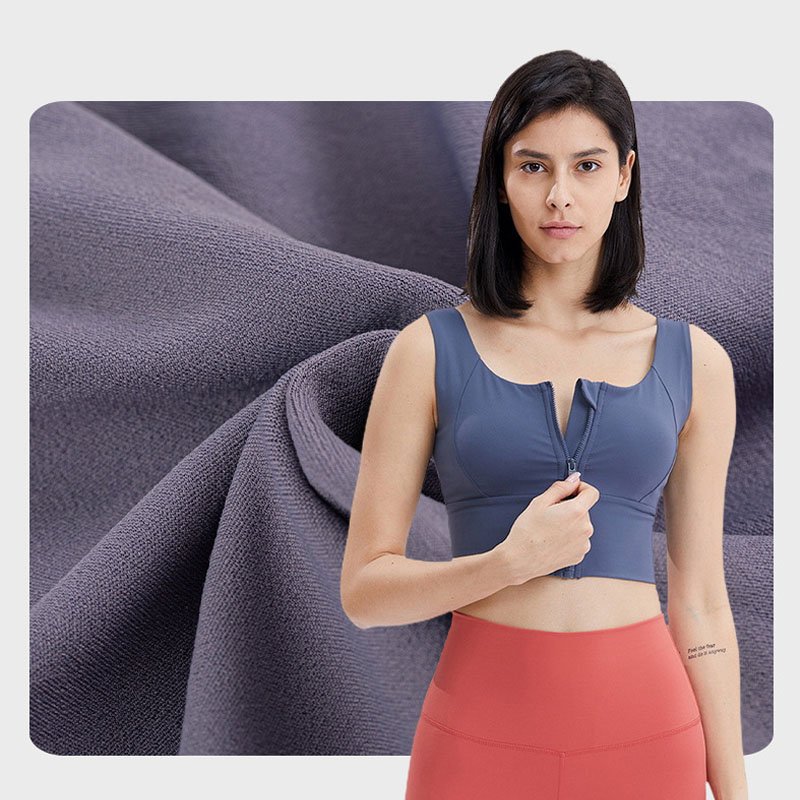Tricot fabric is a warp-knitted textile celebrated for its unique properties and remarkable versatility. Its construction results in a smooth surface on one side and a textured, ribbed back on the other, giving it a distinctive dual texture.
This dual texture is achieved through a zigzag weave pattern, offering an ideal combination of softness and durability. These qualities make tricot fabric particularly suitable for activewear and intimate apparel.
To better understand tricot fabric, let’s explore its key characteristics, the manufacturing process, and common uses.

Tricot fabric features a smooth surface on one side and a textured, ribbed back on the other, achieved through a zigzag weave pattern – True
Tricot fabric is a handwoven textile known for its rough texture and limited use in fashion applications – False
What Are the Characteristics of Tricot Fabric?
1. Texture
Tricot fabric is known for its distinctive texture. It features a smooth surface on one side and a textured back. This unique structure is achieved through a zigzag or ribbed weave pattern, significantly influencing the fabric’s overall feel and appearance.
The smooth surface provides a soft touch, while the textured back offers durability. This combination ensures that tricot fabric remains comfortable to wear while being long-lasting.
The zigzag weave pattern in tricot contributes to its texture and enhances the fabric’s ability to retain shape and structure. The interplay of smoothness and texture makes tricot ideal for various garment applications, especially those that require both comfort and durability.
Tricot features a smooth surface on one side and a textured back, created by its distinctive zigzag or ribbed weave pattern – True
Tricot fabric has a rough texture on both sides, making it uncomfortable for long wear – False
2. Stretch and Recovery
Tricot fabric is known for its excellent stretch properties, thanks to its warp-knit construction. This allows it to stretch and return to its original shape, making it an excellent choice for form-fitting garments.
The stretchability of tricot ensures that garments made from this fabric conform to the body, providing both comfort and a flattering fit. Its ability to recover well after being stretched is key to maintaining the shape and integrity of the garment.
The warp-knit construction used in tricot fabric offers not just stretch, but also resilience. This structure allows the fabric to maintain its form even after repeated use, making it ideal for activewear, swimsuits, and other items that demand flexibility without compromising shape retention.
Tricot fabric exhibits excellent stretch properties due to its warp-knit construction, allowing it to recover well after being stretched – True
Tricot fabric lacks stretch and does not return to its original shape after being stretched – False
3. Resistance
Tricot fabric is highly resistant to runs and snags, making it an excellent choice for activewear and lingerie. This durability sets it apart from many other fabrics, ensuring longevity and performance.
The fabric’s resistance to running means that it is less likely to unravel or form snags, even under frequent use. This contributes to the fabric’s ability to maintain its appearance and functionality over time.
Tricot’s resistance to runs is attributed to its unique construction and how the fibers interlock. This feature extends the life of garments and makes the fabric suitable for use in environments where durability is critical, such as sports or daily wear.
Tricot is known for its run-resistance, meaning it is less likely to snag or unravel compared to other fabrics – True
Tricot fabric is prone to frequent snags and unraveling, making it unsuitable for activewear – False

What is the manufacturing process of tricot fabric?
Tricot fabric is produced using a flatbed knitting machine, distinguishing it from knit fabrics typically made with circular knitting machines. This difference in equipment contributes to the tricot’s unique characteristics.
In the flatbed knitting process, each needle loops its own thread. This results in parallel rows of interlocked stitches forming the fabric’s distinctive patterns. The structure created by these rows gives tricot fabric its smooth surface and durability.
- The flatbed knitting machine moves back and forth, allowing each needle to loop its own thread independently.
- As the needles loop the threads, they interlock to form parallel rows of stitches.
- This process creates the characteristic zigzag or ribbed patterns of tricot fabric.
- The interlocking of the threads ensures strength and resilience, which enhances the fabric’s overall durability and versatility.
Tricot is produced using a flatbed knitting machine, with each needle looping its own thread to create parallel rows of interlocked stitches – True
Tricot is produced using a circular knitting machine, with each needle looping multiple threads simultaneously to form the fabric’s pattern – False

What is tricot fabric use for?
Due to its unique properties, tricot fabric is highly versatile and widely used in various applications. Its stretch, moisture-wicking capabilities, soft texture, and durability make it suitable for activewear, lingerie, and garment lining.
In activewear, tricot’s ability to stretch and wick away moisture makes it ideal for sportswear and swimwear. The fabric’s soft texture in lingerie provides exceptional comfort, while its stability and smooth finish make it a popular choice as a lining material in garments.
- Activewear: Tricot’s stretch properties and moisture-wicking capabilities make it an excellent choice for sportswear and swimwear, providing both comfort and performance during physical activities.
- Lingerie: Tricot fabric’s soft and smooth texture, combined with its breathability and comfort, makes it ideal for undergarments, contributing to a comfortable fit.
- Lining Material: Tricot is often used as a lining material in garments. Its smooth finish and stability help maintain the shape and structure of the garment, providing a polished and professional appearance.
Tricot Fabric Application Table
| Application | Key Properties | Benefits |
|---|---|---|
| Activewear | Stretch, moisture-wicking | Comfort, enhanced performance, quick-drying |
| Lingerie | Soft texture, comfort, breathability | Comfort, smooth fit, skin-friendly |
| Lining Material | Smooth finish, stability | Enhances garment structure, professional appearance |
Tricot fabric’s stretch and moisture-wicking capabilities make it suitable for activewear and swimwear, while its soft texture and stability make it ideal for lingerie and lining material – True
Tricot fabric is unsuitable for activewear or lingerie due to its lack of stretch and moisture-wicking properties – False

What is the composition of tricot fabric?
Tricot fabric can be made from various fibers, each offering different benefits. Synthetic fibers like polyester, nylon, and spandex are commonly used for their stretch and durability, while some blends may include natural fibers such as cotton or wool.
Synthetic fibers are more commonly used in tricot fabric due to their performance characteristics, such as stretch, moisture-wicking, and enhanced durability. Natural fibers, though less common, may be included in certain blends for added comfort and breathability.
- Synthetic Fibers: Polyester, nylon, and spandex are widely used in tricot fabric due to their ability to provide stretch, durability, and moisture-wicking properties. These fibers are ideal for performance-oriented garments like activewear and swimwear.
- Natural Fibers: Cotton and wool occasionally blend with synthetic fibers to improve softness and breathability. However, they are less common because they don’t offer the same level of performance as synthetics.
- Blends: Tricot blends incorporate synthetic and natural fibers to combine the best of both worlds, enhancing comfort while maintaining performance qualities.
Tricot Fabric Fiber Composition Table:
| Fiber Type | Common Materials | Key Properties | Common Applications |
|---|---|---|---|
| Synthetic Fibers | Polyester, Nylon, Spandex | Stretch, durability, moisture-wicking, quick-drying | Activewear, swimwear, sportswear |
| Natural Fibers | Cotton, Wool | Softness, breathability, comfort | Lingerie, casual wear (in blends) |
| Blends | Synthetic + Natural Fibers | Combination of performance and comfort | Fashion, sportswear, everyday garments |
Tricot fabric can be made from both synthetic fibers (like polyester, nylon, and spandex) for performance and durability, and natural fibers (like cotton or wool) for added comfort, though synthetic options are more prevalent – True
Tricot fabric is exclusively made from natural fibers such as cotton and wool, making it unsuitable for activewear or swimwear – False

Conclusion
Tricot fabric stands out for its unique blend of comfort, durability, and versatility, making it a favored choice in the fashion and textile industries. Its distinct structure, characterized by a smooth surface and textured back, offers both softness and durability, making it perfect for a range of applications, from activewear to lingerie. The warp-knitted construction ensures excellent stretch, recovery, and resistance to runs, while the fabric’s ability to incorporate both synthetic and natural fibers provides flexibility in performance and comfort.
Whether used in sportswear, undergarments or as a lining material, tricot’s adaptability to various needs makes it an essential fabric in modern fashion. Understanding the key characteristics, manufacturing process, common uses, and fiber composition of tricot fabric reveals why it is a preferred choice for many garment types, combining functionality and style.

